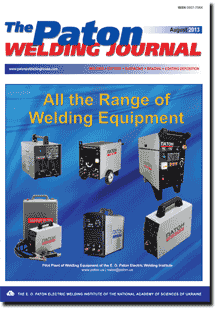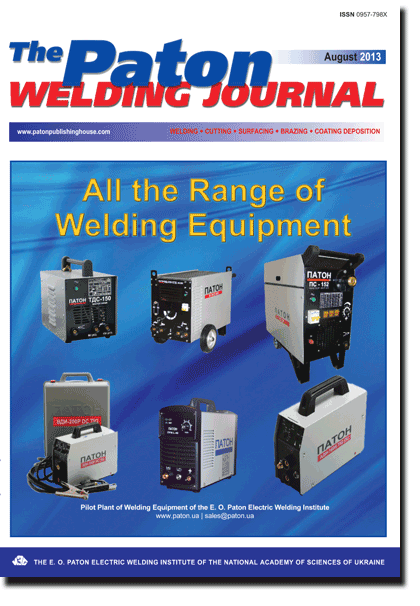| 2013 №08 (01) | 2013 №08 (03) |

The Paton Welding Journal, 2013, #8, 7-12 pages
STRUCTURE AND PROPERTIES OF STEEL 35L WELDED JOINTS PRODUCED USING MULTILAYER ELECTROSLAG WELDING
S.M. KOZULIN1, I.I. LYCHKO1 and G.S. PODYMA2
1E.O. Paton Electric Welding Institute, NASU. 11 Bozhenko Str., 03680, Kiev, Ukraine. E-mail: office@paton.kiev.ua
2NTUU «KievPolytechnicUniversity».6/2 Dashavskaya Str., 03056, Kiev, Ukraine. E-mail: meganom8@ukr.net
Abstract
In multilayer electroslag welding the heat generated in the process of producing each layer effects the earlier welded areas of a groove performing its partial heat treatment and improving its mechanical properties. The aim of the work is the study of effect of thermal cycle on the structure and mechanical properties of welded joint in multilayer electroslag welding using consumable nozzle. The measurements of thermal cycles of the metal of heat affected zone were carried out. To study the effect of self-heat treatment on the structure and properties of welded joints the investigations were carried out including macro- and microanalysis of weld layers and their heat affected zones as well as mechanical tests of the characteristic areas of welded joints. It was found that in the overheating zone of base metal, not exposed to the reheating, the growth of grains reaches N2 and N1 according to the GOST 5639-82 and in the zones of reheating (self-heat treatment) Е N7 and N8. The hardness of metal of layers and areas of heat affected zone exposed to reheating is on average by 20 % lower than that of the areas of heat affected zone with base metal not exposed to reheating. It was shown that in multilayer electroslag welding alternatively from one edge of a butt to another one the volume of self-heat treatment of the layers of multilayer electroslag weld reaches 38.4 %. In multilayer electroslag welding with deposition of layers from the middle of a butt to its edges, the volume of self-heat treatment of the first (central) layer reaches 87 % and the rest (except of the external layers) is 30-43 %. It was established that the width of heat affected zone scarcely depends on specific energy input in the investigated range of its values. 19 Ref., 10 Figures.
Keywords: multilayer electroslag welding, thermal cycle, self-heat treatment, heat affected zone, mechanical properties, impact toughness
Received: 30.05.13
Published: 28.08.13
References
1. Rykalin, N.N. (1954) Calculations of heat processes in welding. Moscow: Mashgiz.
2. Makara, A.M., Gotalsky, Yu.N. (1955) Investigation of thermal cycle of near-weld zone in electroslag welding in connection with problem of hardenable steels. Avtomatich. Svarka, 5, 25-32.
3. Sushchuk-Slyusarenko, I.I. (1964) Deformation compensation in electroslag welding. Ibid., 1, 28-33.
4. Sushchuk-Slyusarenko, I.I. Electroslag welding and cladding. Moscow: VINITI.
5. Filchenkov, D.I., Kozulin, M.G. (1979) Calculation of thermal cycle for near-weld metal in electroslag plug welding. Svarochn. Proizvodstvo, 1, 1-2.
6. Sushchuk-Slyusarenko, I.I., Lychko, I.I., Kozulin, M.G. et al. (1989) Electroslag welding and cladding in repair operations. Kiev: Naukova Dumka.
7. Sushchuk-Slyusarenko, I.I., Vergela, A.G., Shevchenko, N.T. (1969) Electroslag welding-up of cracks. Avtomatich. Svarka, 4, 72-73.
8. Kozulin, S.M., Lychko, I.I. (2011) Deformations of welded joints in multilayer electroslag welding. The Paton Welding J., 1, 23-27.
9. Zemzin, V.N., Shron, R.Z. (1978) Heat treatment and properties of welded joints. Leningrad: Mashinostroenie.
10. (1959) Electroslag welding. Ed. by B.E. Paton. Kiev: Mashgiz.
11. Yushchenko, K.A., Kozulin, S.M. (2012) Specifics of electroslag welding technology for repair of defects in large parts of machine building units on-site of their operation. In: Proc. of 3rd Sci.-Techn. Conf. on Welding Production in MachineBuilding: Prospects of Development (2-5 Oct. 2012). Kramatorsk: DGMA, 2012.
12. Kozulin, S.M. (2011) Selection of the groove shape for repair of through cracks by multilayer electroslag welding. The Paton Welding J., 3, 32-35.
13. Kozulin, S.M., Lychko, I.I., Kozulin, M.G. (2007) Methods of reconditioning rotary kilns (Review). Ibid., 10, 33-39.
14. Popov, A.A., Popova, L.E. (1961) Reference book of heat-treater. Isothermal and thermokinetic diagrams of decomposition of supercooled austenite. Moscow: Mashgiz.
15. Shorshorov, M.Kh., Belov, V.V. (1972) Phase transformations and change of properties of steel in welding. Moscow: Nauka.
16. Makara, A.M., Kovalyov, Yu.Ya., Novikov, I.V. (1972) Tears on near-weld zone in electroslag welding of structural steels. Avtomatich. Svarka, 5, 1-5.
17. Sorokin, V.G., Volosnikova, A.V., Vyatkin, S.A. et al. (1989) Reference book of steel and alloy grades. Ed. by V.G. Sorokin. Moscow: Mashinostroenie.
18. Livshits, L.S. (1979) Metals science for welders. Moscow: Mashinostroenie.
19. GOST 9770-88: Steel casts. General specifications. Intergovernmental standard. Introd. 01.01.90.
Suggested Citation
S.M. KOZULIN1, I.I. LYCHKO1 and G.S. PODYMA2 (2013) STRUCTURE AND PROPERTIES OF STEEL 35L WELDED JOINTS PRODUCED USING MULTILAYER ELECTROSLAG WELDING. The Paton Welding J., 08, 7-12.The cost of subscription/purchase order journals or individual articles
| Journal/Currency | Annual Set | 1 issue printed |
1 issue |
one article |
| TPWJ/USD | 384 $ | 32 $ | 26 $ | 13 $ |
| TPWJ/EUR | 348 € | 29 € | 24 € | 12 € |
| TPWJ/UAH | 7200 UAH | 600 UAH | 600 UAH | 280 UAH |
| AS/UAH | 1800 UAH | 300 UAH | 300 UAH | 150 UAH |
| AS/USD | 192 $ | 32 $ | 26 $ | 13 $ |
| AS/EUR | 180 € | 30 € | 25 € | 12 € |
| SEM/UAH | 1200 UAH | 300 UAH | 300 UAH | 150 UAH |
| SEM/USD | 128 $ | 32 $ | 26 $ | 13 $ |
| SEM/EUR | 120 € | 30 € | 25 € | 12 € |
| TDNK/UAH | 1200 UAH | 300 UAH | 300 UAH | 150 UAH |
| TDNK/USD | 128 $ | 32 $ | 26 $ | 13 $ |
| TDNK/EUR | 120 € | 30 € | 25 € | 15 € |
AS = «Automatic Welding» - 6 issues per year;
TPWJ = «PATON WELDING JOURNAL» - 12 issues per year;
SEM = «Electrometallurgy Today» - 4 issues per year;
TDNK = «Technical Diagnostics and Non-Destructive Testing» - 4 issues per year.


